Automotive industry applications rely heavily on the GMSL technology from Analog Devices due to its flexibility and performance. GMSL cameras are prominent in use cases that require high-speed data transmission, as well as long distance support (up to 15m), without compromising on signal quality. In comparison, MIPI (which stands for Mobile Industry Processor Interface), has tight restrictions and allows placing an SoC just in 10-15 cm apart from an image sensor in order to avoid signal integrity degradation.
The figure below illustrates a camera block diagram that features 4 camera units connected to a Printed Circuit Board (PCB) with SoC via set of GMSL SerDes and coax cables of different length. Such distance between cameras and PCB allows more practical applications in the world avoiding problems with signal integrity.
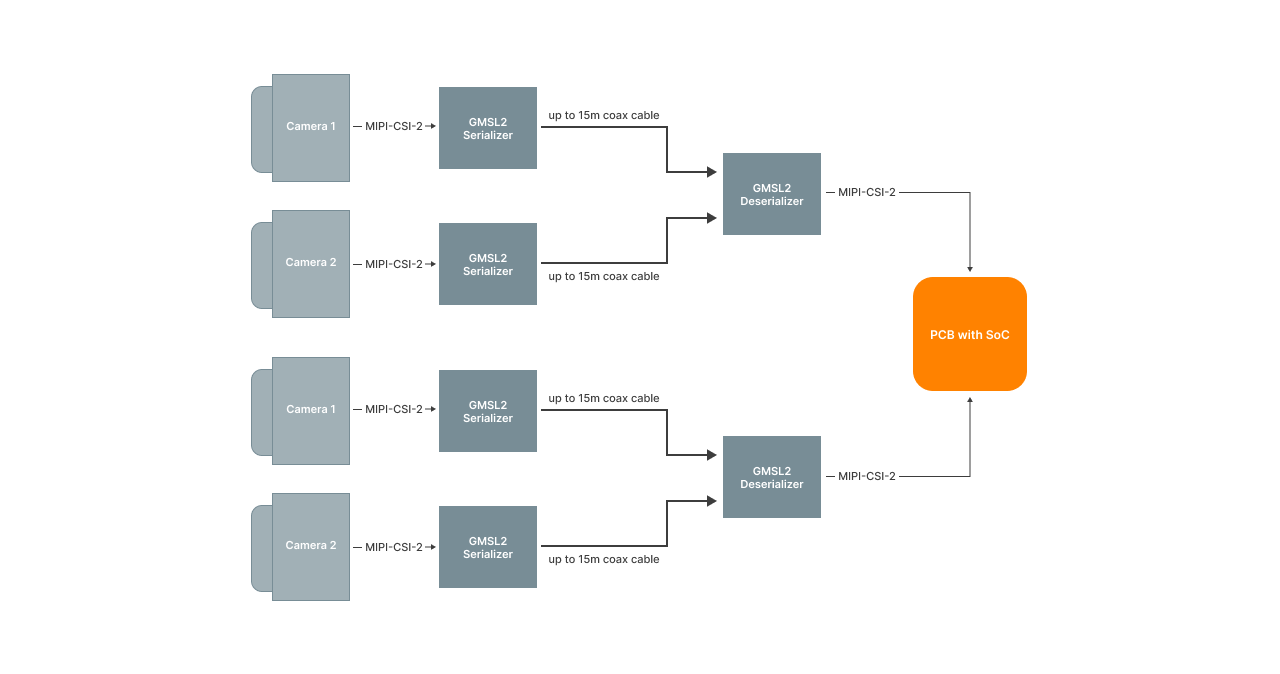
GMSL camera for automotive applications
This section is dedicated to automotive applications in which GMSL cameras are used. The image below is the illustration of an actual automotive use case in which GMSL technology is widely adopted. Looking at the picture, we can see how a 15m cable is able to reach the back of the truck in order to record and deliver information to the driver. That is a basic blind spot area of any vehicle and requires the attention of drivers when parking. Other blind spot places, that are just as important and sometimes even extra crucial for a heavy ground vehicle, are at the front and on both sides, where cameras with shorter GMSL cables can capture vulnerable road users.
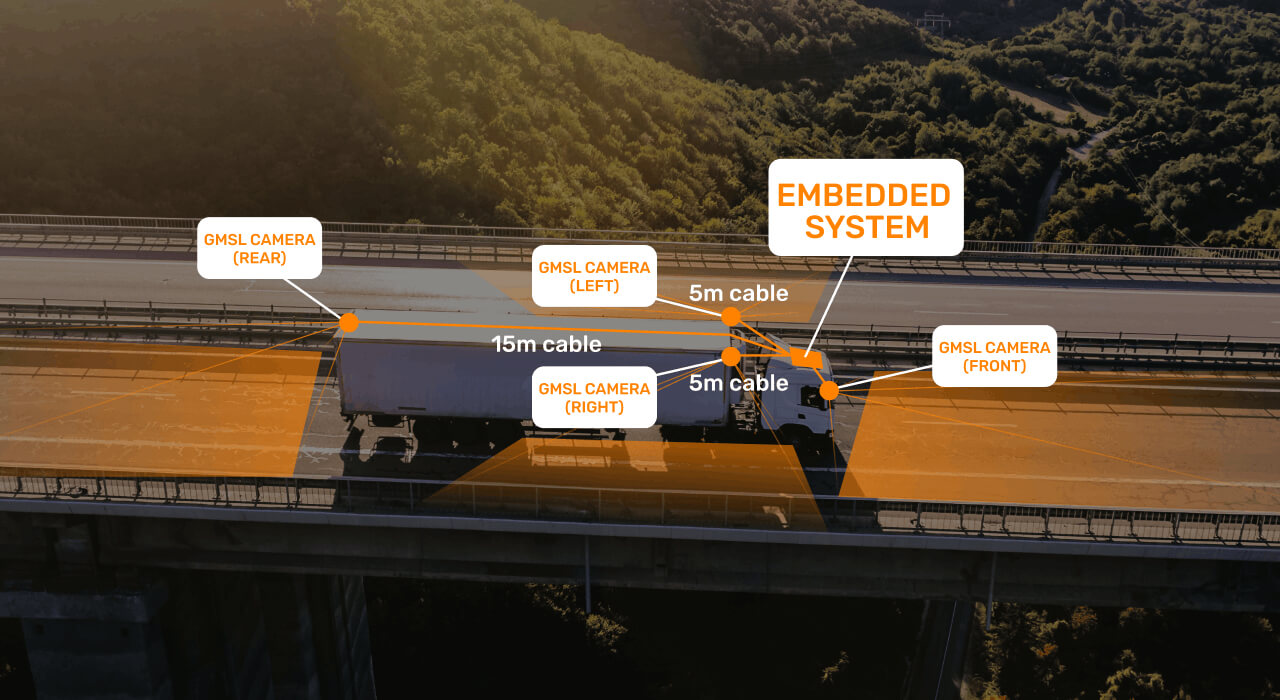
Unfortunately, people and bikes have a higher risk of going unnoticed and getting harmed. That is the case of commercial and industrial fleets. Camera Monitor Systems (CMS) are a way to solve the problem, with Stoneridge-Orlaco featuring the CornerEye system with a GMSL interface as a solution to avoid front and side collisions. Other large size vehicles for mining, or public transportation have similar driving safety issues, Continental presented ProViu360, a real-time Surround View System (SVS), addressing the agricultural vertical. Motec specializes in heavy duty camera systems. In addition, AI-powered CMS, SVS and other blind spot detection cameras are getting popular to such an extent that some day in the future, it may become a legal requirement for their integration in vehicles.
It is not only trucks and other large cars that integrate GMSL cameras with Advanced Driver Assistance Systems (ADAS), but also regular-sized vehicles with Automated Driving System (ADS) functionalities as well. According to Alex Lynn at Electronic Specifier, current GMSL2 performance is sufficient for partial or conditional automation (level 2 & 3) when, for example, automated parallel parking is provided. As demand for ADAS and ADS technologies continues to grow, more companies are likely to adopt GMSL for their products.
The main consumers of GMSL cameras are OEM and Tier1 suppliers in the automotive industry. Here are some examples of companies from which you can expect the integration of GMSL.
Tesla is one of the leading companies in development of autonomous driving technologies. The company uses GMSL2 cameras in its Autopilot system, which provides advanced driver assistance features.
General Motors use GMSL cameras in their Super Cruise system, which provides hands-free driving assistance on highways.
Ford uses GMSL cameras in their Co-Pilot360 system, which provides various driver assistance features.
Electronic Control Unit with GMSL cameras
These are just a few examples of companies that are buying GMSL cameras. The basis of such systems is an Electronic Control Unit (ECU) in which all video and AI processing happens. Taking this into account, Rhonda Software decided to ease the process of adoption of GMSL cameras and enable faster time to market for new automotive vision systems. Rhonda Software designed the Ambarella CV2 SoC-based ECU, a camera development platform that supports up to 6 GMSL cameras and is able to run multiple Neural Networks.
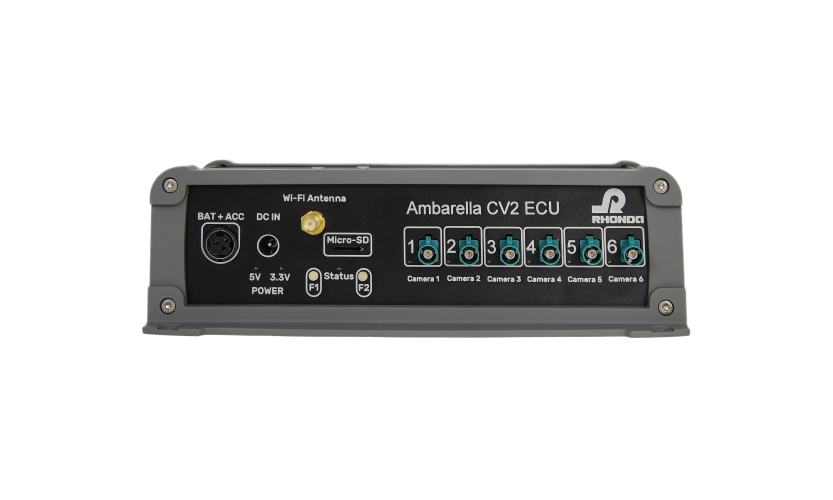
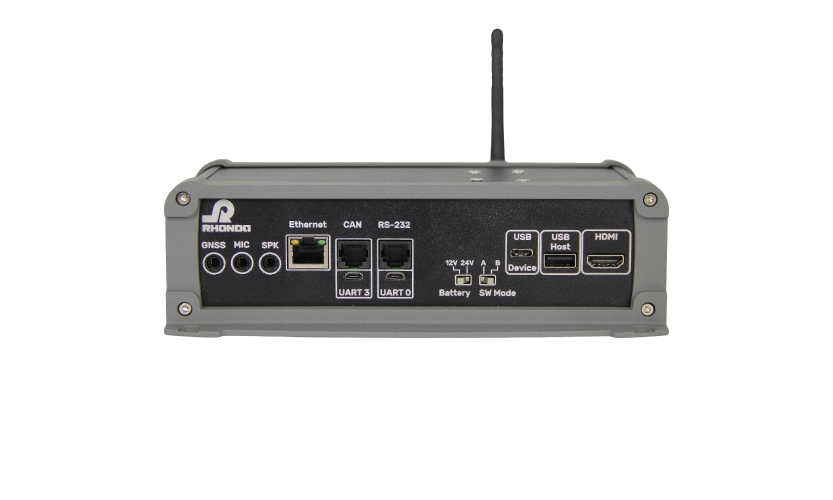
The fact that the hardware platform is based on Ambarella automotive silicon, gives reassurance in the quality of a future camera product. Ambarella hardware has recommended itself for
1. Proven high AI performance
2. Great quality video processing
3. Very low power consumption
GMSL camera technology limitations
GMSL is inevitably growing ever more popular, but there are certain limitations to its adoption by system developers, as well as automotive OEMs and Tier1 companies. While the automotive industry is a major customer for GMSL cameras, this is still a limited market compared to the broader camera market (nevertheless, warehouse robotics, agriculture and medicine verticals have also started integrating GMSL). Therefore, there are limited economies of scale, which contribute to higher costs of GMSL cameras. The cost of the cameras themselves and also the development resources (the amount of time, human labor, and financial investments) on hardware and software for data transmission and processing can be a barrier for some companies.
GMSL2 camera EVK
The Rhonda GMSL2 camera EVK is an evaluation kit that was designed by experienced engineers that specialize in imaging projects, and consists of:
Camera module based on the Sony IMX577 optical module and a GMSL2 serializer board
Compute module based on the Rhonda H22 SoM and a GMSL2 deserializer board
Up to 15m FAKRA-Z coaxial cable
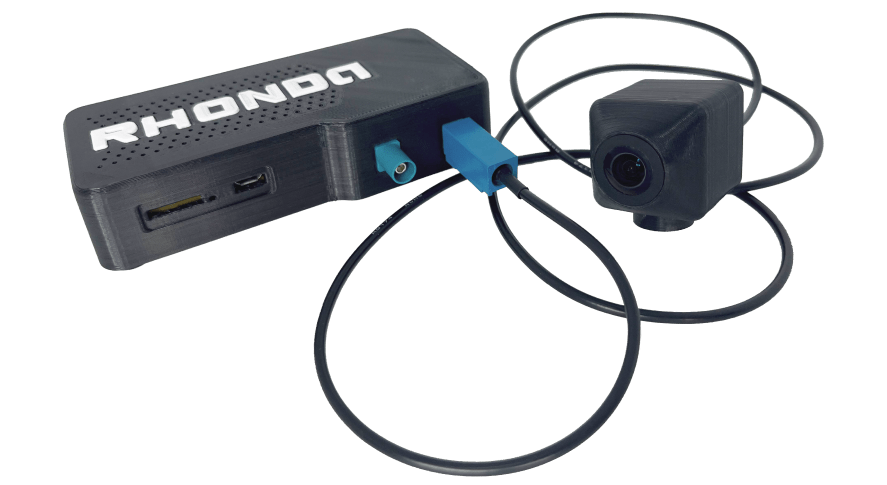
As a result, the camera EVK is meant to be used in customers' own camera projects that require integration of GMSL capabilities.
The main advantages of this GMSL EVK are the bandwidth suitable for 4K@30 fps, nearly zero-latency transmission of uncompressed data, and the ability to multiplex additional metadata along with video and ability to provide enough power for the camera and additional equipment (such as an IR projector). Some other benefits are that the EVK is based on the Rhonda H22 SoM with the Ambarella H22 SoC inside, which minimizes power consumption (up to 3W, lab tested data: 2.75W with one camera streaming 4K@30 fps over UVC) while maximizing video performance in a small form factor.
Finally, GMSL cameras can have various features such as HDR, low light sensitivity, and image stabilization. As the market for GMSL cameras expands and evolves, camera suppliers adjust their specification and feature sets based on the market changes and needs of end-users. This GMSL2 EVK is ready to be customized upon customer specific applications.
Summary
The key difference between standard MIPI and GMSL is the distance between a camera unit and processor.
MIPI vs GMSL = 15 cm vs 15 m distance between a camera and the processor.
The automotive industry is the main customer for GMSL cameras. The level of integration varies from camera monitor systems without AI to advanced driving features.
GMSL cameras are more complex than traditional cameras, which can make them more difficult to integrate into existing systems. This can require additional expertise and resources, which may not be readily available for all companies. This problem can be solved when you contact an experienced camera design partner for custom camera development or evaluation of the existing GMSL hardware.
References
Analog Devices. Gigabit Multimedia Serial Link (GMSL)
Stoneridge-Orlaco. CornerEye: Truck Blind Spots Made Visible Thanks to a 270 Camera
Continental. ProViu360: Product Information
Motec. Heavy-Duty Camera Solutions
Electronic Specifier. The future of autonomous vehicle camera safety systems
Tesla. Autopilot
General Motors. GM Super Cruise
Ford. Ford Co-Pilot360TM Technology
Rhonda Software. Rhonda Software introduces the Ambarella CV2-based ECU platform
Ambarella. Automotive | Ambarella
Rhonda Software. How to choose an Ambarella CVflow SoC for your camera
Rhonda Software. GMSL2 camera EVK
Rhonda Software. GMSL cameras grow popular for embedded vision projects

